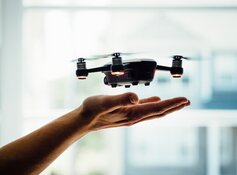Recent efforts to enact binding rules governing the use of lethal autonomous drones by militaries worldwide failed to gained ground, and demand for all types of defense unmanned aerial vehicles (UAVs) is on the rise, good news for U.S. companies developing and supplying them.
"The result has been to tie the debate up in a procedural knot with little chance of progress on a legally binding mandate any time soon," an article in The New York Times noted.
Lethal autonomous (self-piloted or artificial intelligence [A.I.]-controlled) drones, also called kamikaze, suicide, loitering munition and exploding drones, can hover over the area of a target until identifying it then navigate themselves directly into the target and explode.
Certain countries like Austria are pushing for imposed limits, but others, including the U.S., Russia, Australia and Israel, refute there is a need for such restrictions now.
The current Hamas-Israel conflict brought a sense of urgency to this issue, the Times article indicated. This is because in their fighting, reportedly Hamas has deployed suicide drones and mostly for indoor combat in small spaces, the Israel Defense Forces have used autonomous drones.
Before Israel and Hamas, Russia and Ukraine were in the news for employing A.I.-powered drones in their ongoing war.
"Autonomous drones play a significant role in today's conflicts, asserted a September 2023 article in Drone Life. "They augment their human operators, delivering critical goods to dangerous locations (e.g., blood to the front lines), detecting dangers (e.g., hidden land mines) and rapidly resupplying units. In the right scenarios, drones can conduct life-saving missions."
Drones' widespread usefulness in the defense setting translates to continuing and growing need around the world for both human- and self-piloted drone systems.
The Catalyst: The Rise of A.I-Powered Drones
Forecasts predict appreciable growth of the global military drone market over the next handful of years.
Specifically, it is projected to reach $17B in value by 2027 from $12B in 2022, a 42% increase, according to MarketandMarkets. In the subsonic category, into which most military drones fall, the increasing demand for lethal self-piloted drones will boost growth of the greater than 300 kilometers per hour (300 km/hr) segment. Increasing use of tactical drones for in situ recovery applications will boost growth in the 100−300 km/segment, and rising demand for small drone platforms will boost growth in the less than 100 km/hr segment.
The new innovative defense technology, Politico pointed out in a November 2023, is "often supplied directly by newer, smaller manufacturers, outside the traditional nation-to-nation negotiations for military supplies." From an investment point of view, these types of companies in the U.S. are the ones to watch, given the country, according to Statista, remains the leader of drone technology.
Red Cat Holdings Inc.
One such U.S. company is Red Cat Holdings Inc. (RCAT:NASDAQ). Headquartered in Puerto Rico and with a manufacturing facility in Salt Lake City, Utah, the company develops and manufactures robotic hardware and software for use in aerial military and other operations.
One of its products, designed for warfighting in darkness, is the Teal 2 small unmanned aircraft system (SUAS), outfitted with ultra high-resolution thermal imaging. Red Cat Holdings describes the drone as modular, rugged, secure and easy to fly. The Teal 2 is UAS Blue, meaning it is U.S. Department of Defense approved. It complies with the Federal Aviation Administration's Remote ID requirement, meaning it can provide identification and location in flight, via a broadcast signal.
Red Cat had a $7.5 million ($7.5M) backlog of Teal 2 orders as of Sept. 20, 2023, ThinkEquity Analyst Dr. Ashok Kumar wrote in a research report. He forecasted the company's total revenue will increase 88% between fiscal years 2023 and 2024, rising to $18.6 million from $9.9M.
"Fiscal 2024 will be a year of Teal 2 production, sales and revenue," Kumar said.
ThinkEquity's rating on Red Cat Holdings was Buy and its target price, $5 per share.
Technical Analyst Clive Maund recommended in July 2023 that investors "stay long" in RCAT.
As for Red Cat Holdings' share structure and ownership, the company has 74.16 million shares outstanding, according to Fintel. Of those, 37.91%, or 28.11M shares, are held by 24 insiders. Those owning more than 1M shares each are Chairman of the Board, CEO and Director Jeffrey Thompson with 12.96M shares, CEO of Fat Shark RC Vision Systems Gregory Ralph French with 4.81M shares, Director Lou Werner with 4.08M shares, Brains Riding in Tanks LLC with 1.99M shares and COO Allan Thomas Evans with 1.44M shares.
Red Cat has 41 institutional owners that together hold 4.08M shares or 5.23% of the company. Of these, the five with the greatest holdings are, in order from most to least, Vanguard Group Inc. with 1.3%, Pelion Inc. with 0.9%, Vanguard Total Stock Market Index Fund Investor Shares with 0.85%, Vanguard Extended Market Index Fund Investor Shares at 0.4% and UMB Bank with 0.34%.
Retail investors own the remaining 56.86% of Red Cat Holdings.
The company has a market cap of $46.75M. Its share price over the past 52 weeks ranged from $0.52 to $1.54.
Firestorm Labs Inc.
Another U.S. company in the defense drone sector, in which Red Cat Holdings has invested, is Firestorm Labs Inc., based in San Diego, California. Launched in 2022, this private company is building wholly modular unmanned aerial systems (MUAS) rapidly, cheaply and in large quantities for use by militaries.
The modular nature allows customers to modify configuration and operation of the drone based on need in the field. Firestorm creates the components chosen for a system with three-dimensional printers, then uses a flight computer, equipped with artificial intelligence and machine learning applications, to cement the pieces together, a DroneDJ article described.
"The process," Firestorm Co-founder Dan Magy told DroneDJ, "is capable of producing a 25 pound capacity drone in about nine hours, fully testing it in roughly 24 hours and delivering it to end users for set-up and deployment between 48 and 72 hours of ordering."
Red Cat Holdings' CEO Jeff Thompson told Defense Advancement that "Firestorm is changing how UAVs can be designed, manufactured and delivered quickly, and the Firestorm system solves a lot of problems for many critical situations. Their long-range and long-duration loitering capabilities are a cost-effective approach to winning in the air."
Just last month Firestorm partnered with the Air Force Special Operations Command and the Air National Guard to expedite the development of the company's expeditionary manufacturing unit, xCell, to build MUAS on a mass scale, noted a news release.
"The U.S. Air Force's use of xCell will revolutionize the U.S. Department of Defense's reliance on traditional manufacturing processes that disable the real time production and replenishment of capabilities critical to deterring adversaries," explained the release.




































